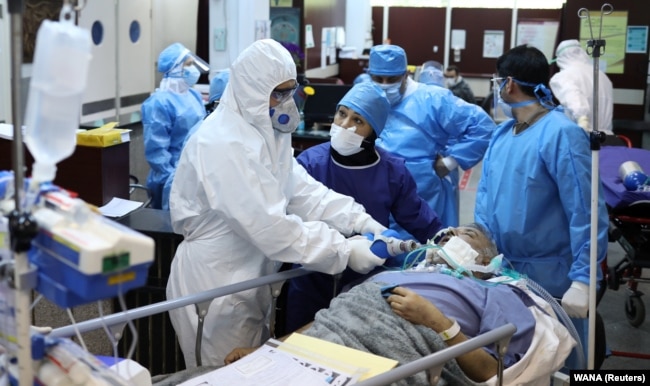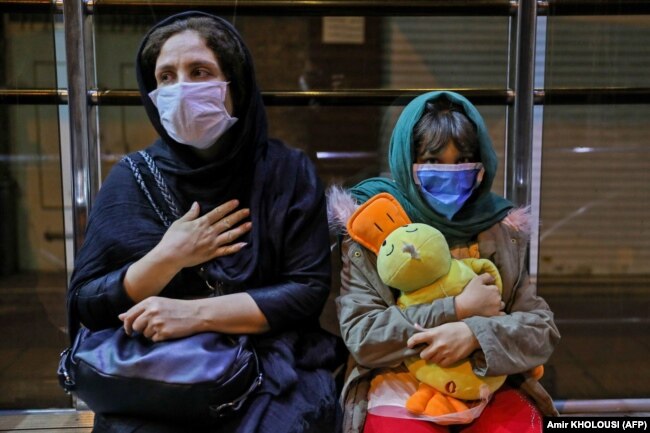RFL/RE – Iran became one of the first coronavirus hot spots outside of China in March when thousands of Iranians began showing respiratory symptoms of COVID-19.
Now Iranian doctors say they are seeing a surge of patients with gastrointestinal problems rather than respiratory symptoms.
In fact, recent medical evidence from China and the United States also suggests there is a subset of gastrointestinal coronavirus patients who don’t display the classic respiratory symptoms of the disease.
It’s a phenomenon that is being scrutinized by medical researchers around the world.
“COVID-19 had symptoms before such as coughing, shortness of breath, and high fever,” says Mohammad Reza Mahboubfar, a viral epidemiologist on Iran’s coronavirus task force.
“These symptoms were observed in the first two months after the outbreak, but now the most important symptoms of COVID-19 are gastrointestinal,” Mahboubfar says.
For both elderly patients and children, Mahboubfar says gastrointestinal symptoms include acute diarrhea, abdominal spasms, stomachaches, nausea, vomiting, and the loss of appetite and sense of smell.
Mahboubfar says these patients often have either a slight fever or no fever at all.
He says that may be affecting the official COVID-19 statistics released by Iran’s Health Ministry because it does not include untested patients who don’t have respiratory symptoms.
Iran’s northern city of Babol was the site in March of one of the country’s first major COVID-19 outbreaks.
Seyed Hassan Abedi, a gastroenterologist at Babol Medical Sciences University, confirms that fewer patients with respiratory symptoms are hospitalized there.
Abedi says about a quarter of all COVID-19 patients in Babol now have only gastrointestinal symptoms.
He says diarrhea in these patients is “acute,” occurring at least five times a day and lasting up to two weeks.

Abedi says the situation is alarming because those with gastrointestinal symptoms usually seek medical care and are tested later than those with more pronounced respiratory symptoms.
He fears the delayed diagnosis of coronavirus in patients with milder gastrointestinal symptoms puts their health at greater risk and can cause the virus to spread faster.
At Shahid Beheshti University in Tehran, gastroenterologist Seyed Reza Fatemi says about half of the COVID-19 patients are showing gastrointestinal symptoms.
Fatemi says up to one-third of those with gastrointestinal symptoms suffer liver damage and inflammation of the pancreas.
And there are other manifestations beyond the lungs, such as evidence of a childhood circulatory syndrome and kidney complications.
Cases of strokes in Iran — including among children — also have been attributed to the coronavirus.
“Oxygen deprivation and inflammation resulting from COVID-19 can result in thrombosis in arteries and brain strokes,” says Dr. Mahmoud-Reza Ashrafi, a professor of medicine at Tehran University of Medical Sciences.
Global Evidence
Medical experts have been aware of gastrointestinal symptoms for COVID-19 since the first outbreak in Wuhan, China, in December.
In the United States, the first confirmed coronavirus infection was a patient who reported nausea, vomiting, and diarrhea for two days along with respiratory symptoms.
The virus was detected in that patient’s stool samples as well as from swab tests of his nose and throat.

What is becoming apparent is that gastrointestinal symptoms are more common than previously thought — most likely because patients without respiratory symptoms weren’t initially being tested for the virus.
Early studies suggested that less than 4 percent of COVID-19 patients had gastrointestinal symptoms.
But the latest research puts the rate at more than 10 percent and as high as 60 percent of all coronavirus infections.
Dr. Martin Veysey, program director of Britain’s Hull York Medical School at the University of York, says there is no doubt that the coronavirus can attack your gut as well as your lungs.
“The molecule which the virus attacks in our bodies — Angiotensin Converting Enzyme 2 or ACE2 — is present not just in our lungs, but in our gastrointestinal tract as well,” Veysey explained via the World Economic Forum’s COVID Action Platform.
“This is what could be behind the significant number of cases in which patients show gastrointestinal symptoms such as diarrhea, nausea, and vomiting,” Veysey said.
In fact, the recent observations about gastrointestinal cases by Iranian experts are mirrored by evidence from China published by reputable peer-reviewed British medical journals like The Lancet and Gut.
One study in Gut concluded that the virus showed up in about half of stool samples collected from coronavirus patients.
The conclusion by medical experts is that the gastrointestinal track is another possible way that people can become infected and transmit the disease.
It’s a revelation that raises enormous public-health concerns in areas that lack adequate sewage and sanitation infrastructure.
In The Lancet, researchers conclude it is possible that COVID-19 could spread via contaminated feces in the same way that dysentery and polio are transmitted.
What is not known, however, is how long coronavirus survives in feces.
That is a question that medical researchers are only now starting to study.
- Ron SynovitzRon Synovitz is a senior correspondent for RFE/RL.[email protected] SUBSCRIBE VIA RSS
- Maryam SinaieeMaryam Sinaiee is a correspondent for RFE/RL’s Radio Farda
 Shabtabnews In this dark night, I have lost my way – Arise from a corner, oh you the star of guidance.
Shabtabnews In this dark night, I have lost my way – Arise from a corner, oh you the star of guidance.


